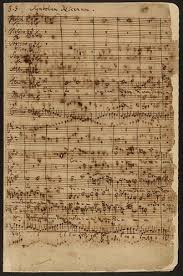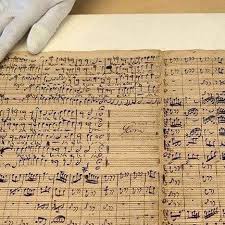The music of Johann Sebastian Bach has long been revered as some of the greatest and most influential works in the classical canon. Among his many masterpieces, the Mass in B minor stands out as a true crowning achievement – a monumental composition that has captivated audiences and scholars alike for centuries. Completed in 1749, just a few years before Bach’s death, this colossal work is widely regarded as one of the supreme accomplishments in the history of classical music.
What makes the Mass in B minor so special? For starters, it is an incredibly ambitious and complex piece, encompassing the full range of human emotion and spiritual depth. Spanning nearly two hours in length, the Mass is a true tour de force, blending intricate polyphony, soaring melodies, and profound theological themes into a cohesive and awe-inspiring whole. But beyond its sheer technical mastery, the work also possesses an almost transcendent quality – a timeless, otherworldly beauty that has the power to move listeners to the core.
In this blog post, we’ll delve deeper into the history, structure, and enduring legacy of Bach’s Mass in B minor. We’ll explore the remarkable circumstances of its creation, examine its innovative musical features, and consider why this work continues to captivate audiences centuries after its completion. Whether you’re a seasoned classical music aficionado or a newcomer to the genre, prepare to be swept away by the sheer majesty and profundity of this truly remarkable composition.
The Origins of the Mass in B Minor
To fully appreciate the significance of the Mass in B minor, it’s important to understand the context in which it was created. Johann Sebastian Bach was born in 1685 in Eisenach, Germany, into a family of renowned musicians. From a young age, he displayed an exceptional talent and passion for music, quickly becoming one of the most skilled and prolific composers of the Baroque era.
Throughout his career, Bach held a variety of prestigious positions, serving as a church organist, court musician, and eventually the Cantor of the Thomasschule in Leipzig. It was during his time in Leipzig, from 1723 until his death in 1750, that Bach produced some of his most celebrated works, including the Mass in B minor.

The origins of this monumental composition can be traced back to the early 1730s, when Bach began assembling a collection of individual mass movements that he had composed over the years. These movements, which were written for various liturgical occasions and performance settings, were gradually compiled and expanded into a comprehensive “mass ordinary” – a setting of the standard texts of the Catholic mass.
Bach’s initial motivation for creating this work was likely practical in nature. As the Cantor of the Thomasschule, he was responsible for providing music for the Lutheran church services in Leipzig, which included the performance of masses. By compiling his existing mass movements into a single, unified work, Bach could ensure that he had a comprehensive mass setting available for these important liturgical events.
However, as Bach continued to refine and expand the Mass in B minor over the course of nearly two decades, it became clear that this was no mere functional piece of liturgical music. The composer’s ambition and artistic vision had transformed the work into something far grander – a true masterpiece that transcended the boundaries of its original purpose.
The Structure and Scope of the Mass in B Minor
The Mass in B minor is a truly monumental work, both in terms of its scale and its musical complexity. Divided into 25 individual movements, the Mass is scored for a large ensemble, including a full choir, four vocal soloists, and a substantial orchestra. The work is structured around the standard sections of the Catholic mass, including the Kyrie, Gloria, Credo, Sanctus, and Agnus Dei.
One of the most remarkable aspects of the Mass in B minor is its sheer scope and ambition. Bach’s compositional approach was to create a work that was not only a comprehensive setting of the mass ordinary, but also a grand synthesis of his lifetime of musical achievements. Throughout the Mass, he drew upon a wide range of stylistic influences and compositional techniques, seamlessly blending elements of Baroque counterpoint, Italian opera, and German chorale tradition into a cohesive and awe-inspiring whole.

The Kyrie, for example, is a masterful exercise in polyphonic writing, with the choir and orchestra weaving a tapestry of intricate, intertwining melodies. The Gloria, on the other hand, is a virtuosic display of Bach’s skill in writing for solo voices, featuring dazzling vocal fireworks and dramatic shifts in mood and tempo.
One of the most iconic and beloved movements in the Mass is the “Crucifixus” from the Credo section. This deeply moving and harmonically complex passage evokes the suffering and death of Christ with haunting poignancy, showcasing Bach’s ability to capture the full range of human emotion through music.
Other standout moments include the majestic Sanctus, which features a soaring, ecstatic choral outpouring, and the serene and contemplative Agnus Dei, which brings the work to a profound and introspective close.
Throughout the Mass in B minor, Bach demonstrates his mastery of musical form and his ability to imbue even the most complex and ambitious compositions with a profound sense of spiritual depth and emotional resonance. It is a work that truly stands as a testament to the limitless power and expressive potential of classical music.
The Enduring Legacy of the Mass in B Minor
Given the sheer scale and complexity of the Mass in B minor, it’s perhaps not surprising that it was not immediately embraced by Bach’s contemporaries. In fact, the work was largely forgotten for several decades after the composer’s death in 1750, overshadowed by the more popular and accessible compositions of the Classical and Romantic eras.
It wasn’t until the early 19th century that the Mass in B minor began to regain widespread recognition and acclaim. In 1829, the young German composer Felix Mendelssohn conducted a landmark performance of the work, sparking a renewed interest in Bach’s music and laying the groundwork for its eventual canonization as one of the greatest achievements in classical music.

Since then, the Mass in B minor has become a staple of the choral and orchestral repertoire, with countless celebrated performances and recordings by some of the world’s most renowned conductors and ensembles. The work’s enduring popularity and critical acclaim can be attributed to a number of factors, chief among them its sheer technical mastery, its profound emotional and spiritual depth, and its timeless, universal appeal.
One of the most remarkable aspects of the Mass in B minor is its ability to transcend the boundaries of time and culture. Despite its origins in the 18th-century Lutheran tradition, the work’s themes of human suffering, redemption, and the search for the divine resonate with audiences of all backgrounds and beliefs. Its rich tapestry of musical styles and influences, from the Baroque to the Romantic, also ensures that the work remains relevant and captivating to listeners across generations.

Moreover, the Mass in B minor has had a profound and lasting impact on the development of classical music as a whole. Bach’s innovative use of counterpoint, his masterful handling of large-scale form, and his ability to imbue even the most complex musical structures with emotional resonance have all had a lasting influence on generations of composers and musicians.
Today, the Mass in B minor is widely regarded as one of the crowning achievements not just of Bach’s oeuvre, but of the entire classical canon. Its enduring popularity and critical acclaim are a testament to the timeless power of this truly remarkable work of art. Whether you’re a seasoned classical music aficionado or a newcomer to the genre, the Mass in B minor is a composition that is sure to leave an indelible mark on your heart and mind.
Conclusion

In the annals of classical music, few works can match the sheer grandeur, complexity, and emotional depth of Johann Sebastian Bach’s Mass in B minor. Completed in the final years of the composer’s life, this monumental composition stands as a testament to the limitless expressive potential of the human voice and orchestra.
From its ambitious scope and innovative musical structures to its profound spiritual themes and universal emotional resonance, the Mass in B minor is a true masterpiece that has captivated audiences for centuries. Whether you’re drawn to the work’s intricate polyphony, its soaring melodies, or its ability to transport the listener to realms of transcendent beauty, there is no denying the enduring power and significance of this truly remarkable composition.
As we continue to explore and celebrate the enduring legacy of Johann Sebastian Bach, the Mass in B minor will undoubtedly remain one of the crowning jewels in the classical canon – a work that continues to inspire, challenge, and move listeners around the world. So let us raise our voices in praise of this timeless masterpiece, and revel in the boundless creative genius of one of the greatest composers to ever live.
